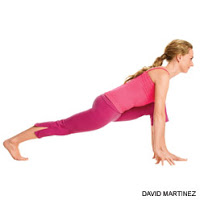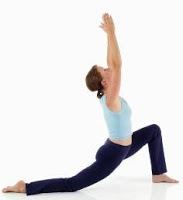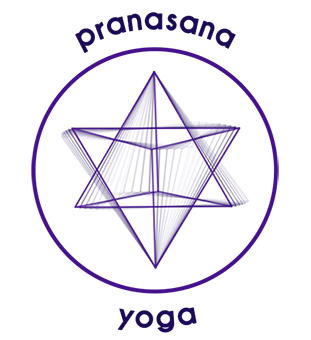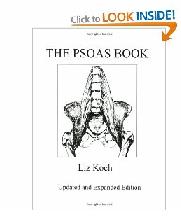Lower back pain, shoulder / neck pain, shallow breath, panic attacks, unnecessary fears, can all find their root to one contracted muscle: The Psoas – The Muscle of the Soul
As we practice yoga more regularly we start getting to know our body and understand its language. Poses like Tadasana (Mountain Pose) teach us about our posture and the tendencies of our bodies: one foot may turn out more, the pelvis may tend to tilt forward or back and the head may tend to move forward of the spine etc…Our past experiences and our lifestyle has shaped our body to where we are today. It is our aim to assist you in maintaining/creating balance and to know your postural tendencies and their remedies.
I begin this series by covering aspects of the Psoas that are worth learning about, especially if you spend most your time sitting behind a computer or in the car. The condition of this muscle is very important for our well being; when short or un-toned it is a cause of many problems. I would like to share with you how to assess yours and give you hints and tips on how to add simple routines to your ‘daily practice’ in order to get the maximum benefit from your yoga. (If you see little squares on the page, click on them to load pictures)
LOCATION AND FUNCTION OF THE PSOAS
 The Psoas Muscle (pronounced “so-az”) is located deep in the belly and forms a bridge between the legs and the torso. It effects how we carry ourselves and when healthy, provides a strong foundation for our trunk.
The Psoas Muscle (pronounced “so-az”) is located deep in the belly and forms a bridge between the legs and the torso. It effects how we carry ourselves and when healthy, provides a strong foundation for our trunk.
It connects the lower back’s vertebrae (T12 to L4) to the top of the thighs near the groin and is responsible for hip flexion (legs towards the spine – in walking, running or biking – or, spine towards the leg – forward bend). It also helps in externally rotating the hip as in tree pose, or triangle (forward leg).
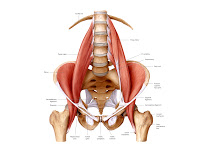
WHY ‘MUSCLE OF THE SOUL’?
I tried finding out the reason for its ‘title’ but didn’t find any reference to it. My own theory is that the more we spend time on the earth, the more gravity affects our body and hence our soul. If we’re not attentive – as the Psoas shortens – our torso starts moving down towards our legs and we get drawn to earthy matters and forget the needs of our soul – we get literally ‘dragged down’ by the earth. If however, we pay attention and keep length in this muscle, we counteract the effect of gravity and maintain our ability to stand straight finding balance between heaven and earth.
PROBLEMS CAUSED BY A CONTRACTED PSOAS
Posture
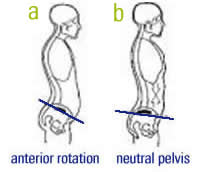
Fig. 3) Tight Psoas creates lordosis in the back as it tilts the pelvis forward. See Also what happens in the Abdomen
As a tight Psoas muscle tilts the pelvis forwards, it creates an exaggerated curve in the lower back. This result in a head forward position which can in turn create soreness in the shoulder and neck. The position of the foot is also affected as the Psoas externally moves the hip out, and this can cause uneasiness in the knee.
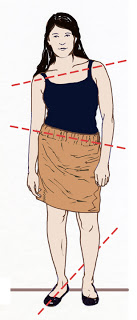
Fig 4) Tight Psoas lifts one hip up, turns the same side foot out
Breathing
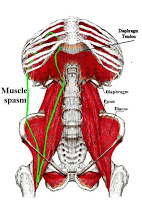
Fig.5
The Psoas is connected to the diaphragm through connective tissue which affects our breath. Hence when the Psoas is in chronic tension, it influences the health of the primary breathing muscle – the diaphragm (fig. 5). Also, as it affects the space in the pelvis and abdomen, it impairs diaphragmatic breathing, which in turn inhibits the nervous system’s engine room for healing. This is why as we reconnect consciously to diaphragmatic breathing in yoga, we also influence the Psoas muscle and help it relax.
Organs
In addition to structural and breathing problems, the limited space in the pelvis and abdomen caused by the shortening of the Psoas constricts the organs (especially the kidneys located right in front of it – fig 6). It also puts pressure on nerves and interferes with the movement of fluids inhibiting the flow of prana to the organs. As it constricts the centre of the body, a shortened Psoas decreases both vitality and the flow of energy.
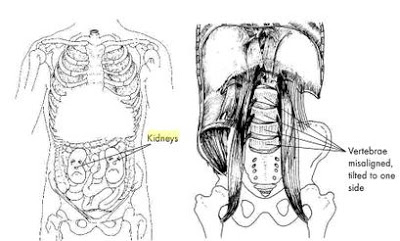
Fig 6) from Energy Balance through the Tao by Mantak Chia
Anxiety and Exhaustion

Fig.7
The tight Psoas muscles are also known to be connected to emotions such as fear. It is a bit of a chicken or egg situation as to whether it is fear that tightens the Psoas, or it is a tightened Psoas that creates unconscious locked fears. Both are true and affect one another. Fear (unresolved, or unreleased) puts the body in foetal ball position bringing the leg closer to the torso – ready to run away – tightening the Psoas. On the other hand, a tight Psoas (due to lifestyle, such as prolonged sitting) over-stimulates the kidney’s and adrenal glands (fig.7) constantly signalling the brain that we’re in danger. This eventually exhausts the adrenal glands and depletes the immune system. In any case, as you become aware of the Psoas, learning to release and relax it, deep held fears are released and your inner sense of peace and equanimity increases. You naturally regain your inner vitality.
THE PSOAS AND YOGA
This muscle plays an important role in our yoga practice: In backbends, a released / un-contracted Psoas allows the front of the thighs to lengthen and the leg to move independently from the pelvis. In standing poses and forward bends, the thighs can’t fully rotate unless the Psoas releases. All yoga poses are enhanced by a released rather than shortened Psoas.
TESTING THE CONDITION OF YOUR PSOAS
Testing the length of the Psoas
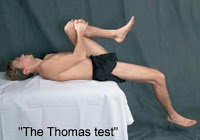
Fig.8
The key here is to keep the back flat on the table to ensure adequate stabilization of the pelvis and to look at the distance between the extended leg and the table (at home you can do this on 2 chair with no handles!). If the leg comes in line with the table the hip flexor is in its optimum length (fig.8) , if it remains higher (fig 9), it will benefit from releasing and lengthening.
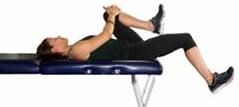
Fig.9
Testing the strength of the Psoas

From a lying position move a leg out away from the other leg, then turn the foot/knee/hip out (externally rotate the leg) and lift the leg up and down slowly.
To ascertain the Psoas notice how much the lower back arches heavily off the floor and how many other muscles contract to help the Psoas to raise the leg: muscles in the other buttock, the neck, the face…If you can perform this without the need to recruit many other muscles and able to isolate your Psoas (so it works independently) it is in good condition strength wise.
BALANCING ROUTINE
If your tests have proven that you do have a contracted/weak Psoas muscle this routine will help you create balance over time. This muscle is very responsive if it is not forced or bullied in any way! So the gentler you are and the more you allow it to open in its own time, the more you’ll reap the benefit.
When it comes to working and bringing awareness to the Psoas, we need to consider ‘releasing (helping it to relax), toning and stretching the muscle’.
RELEASING THE PSOAS is of major importance here. I would say, if you don’t have time, skip toning and stretching but don’t skip RELEASING if these muscles have proven to be tight.
RELEASING
1. Massage
The Psoas is under the large intestine. In order to release it, using massage, you can use a soft blanket or a towel to make a soft ball and place it under the belly lying on the front. Rolling from side to side, you’ll massage the large intestine and its supporting muscle, the Psoas. This has another major benefit associated to it as you’re inevitably massaging the large intestine. Most of the serotonin in the body (responsible for calming, improving moods and releasing anxiety) is found in the guts, so this is a great practice to do before sleep if you find yourself having trouble falling asleep. Generally it is best to do this in the evening.
The Psoas is found on both sides of the navel about 2 inches away. As you roll from side to side try and locate this muscle with your mind’s eye and gently press down. If you feel pain stop immediately, you should not perform this if you have: Any kind of fresh surgery and scarring, inflammatory gut syndrome or condition, any hint of aortic aneurysm, pelvic inflammatory disease or, any type of stomach or intestinal/visceral cancer.

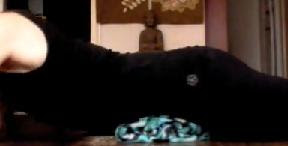
2. Constructive Rest Position
20 minutes (twice a day) is ideal but work with the time available to you. Try to do it at least 5 minutes at a time but you will get much more benefit if you stay longer.
Feel the curve of your lower back, and without using any force or pushing down feel the lower back descending down. Be conscious of sensations in the lower belly on each side of the navel and the front of the hip. Try not to fidget and if any strong emotion or sensation comes to surface breathe into it and let it vanish when it’s ready.

Use a band or scarf around the legs (on the thighs) in order to keep the legs in position, so you don’t have to use too much awareness to keep them from flopping to the side! (legs are hip width apart). This allows you to relax deeply.
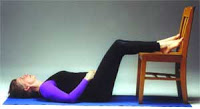
In both case you might put a small towel under the top of the head (above the big bump of the skull) in order to elongate the neck.
3. Constructive Rest Position with the Arms
Then bring your arms up and down towards the floor 5 times and finally relax them down. If they don’t reach the floor place pillows under them to rest. You can stay here for a few breaths.
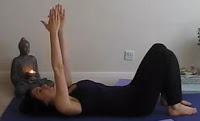

MOVEMENT AWARENESS
Bring your arms back by your side and slowly walk one foot a step at a time away from your pelvis. Move from the front of your hips and try not to move your lower back. As soon as you feel your lower back wanting to curl up, bring the foot back and repeat 3 times on one side, then change.
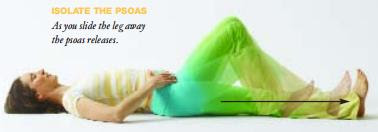
TONING THE PSOAS
1. Lying Down
If your lower back is far from the floor, put a blanket (same height as the distance) under your lower back in order to support the lower back.
a)Pressing the foot on the floor, lift the other leg up and while keeping it off the floor move it up and down (a couple of inches at a time)
b) Then side to side
c) Then diagonal (top right to bottom left)
d) Diagonal (top left to bottom right)
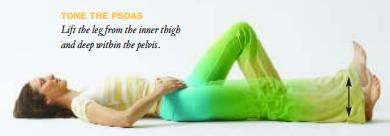
Begin by doing it twice in each direction and then increase as the muscle becomes stronger. It is very important to do this gradually in order to maintain a healthy back. If you feel any pain in the lower back stop. It might also help to put a blanket under the curve of your lower back.
2. On all Fours
Move the leg towards the midline and away in one straight line a couple of inches each time, then up and down.
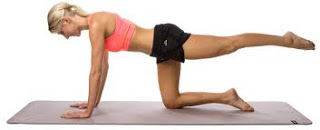
Move the leg up and down while keeping the lower back totally steady, feel the buttock of the lifted leg engage as the front of the hip opens.

3. Reverse Curl Ups
This involves lying on the floor on your back with your hands clasped behind your head (on your forehead or on the centre of the chest if you have a neck problem or if it helps your neck stay relaxed). With your knees towards your chest and lifting your bottom/sacrum off the floor, make your back round so that your knees approach your chin. It is best to lift the bottom slowly off the floor and take it back slowly down too (if your lower belly muscles need strengthening, you’ll be tempted to make jumpy movements, while smiling 🙂 try to keep it smooth). Attempt to do 15-20 at a time, taking care as you lower your legs that your thighs don’t pass beyond the starting point (perpendicular to the floor) not to risk straining the lower back.
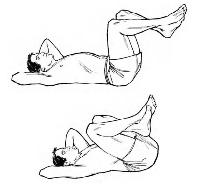
STRETCHING THE PSOAS
Press the hand against the shin and vice versa, use this as a leverage to open the extended leg from the hip. The stretch doesn’t come from the lower back. (if you only see one picture below, click on little square that appear on the page and you’ll see the photo, blogger is having problem with some photos)
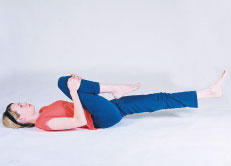

This routine is adapted from Liz Koch’s Psoas Book.
You can then do a simple passive stretch that will not only help stretch your psoas, it will also decompress your lower back:

You do this by lying on your back on the floor with your knees bent. You then lift your bottom and slide a yoga block or a stack of books (1.5 – 5 cm) under your sacrum (the flat bone at the base of your spine) and then one at a time, straighten both legs out, letting them flop. You only remain there for 30 secs to one minute at a time. After removing the Block you must gently rock your knees to your chest until the discomfort in your low back has faded (approximately 30 seconds).
Do this simple sequence until your psoas gets stronger and more supple. You can then add more postures to your routine (below) to target this muscle. Making sure that the pose opens the front of extended hip gently and doesn’t over extend (curve the lower back)
Happy Psoas Muscle to you all!
June 2012
